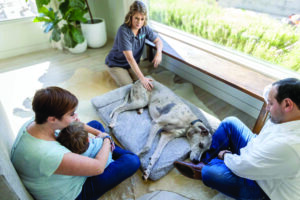By Dr. Beth Leermakers
Putting a beloved furbaby to sleep is one of the most painful responsibilities of pet parenthood. I will never forget taking my first dog, a 6-year-old (too young!) Golden Retriever who had bone cancer that spread throughout his body, for his last trip to the vet. A friend helped me carry my 85-pound baby to the car. I stayed with Laredo during the procedure, with tears streaming down my face. I’m tearing up as I write this, 20 years later.

Photo courtesy of Paws Into Grace
Some pet parents choose in-home euthanasia for their pets, preferring to say goodbye in the comfort and familiarity of their home instead of a sterile veterinary office. In-home euthanasia isn’t right for all pets, but it’s beneficial to many. Here’s what to consider when deciding whether to use this procedure in your home.
When the hospice veterinarian arrives, you’ll discuss your pet’s condition, and the vet may give your pet a brief physical exam. A veterinarian or euthanasia technician usually administers two intravenous injections. The first one is a sedative that relaxes your pet’s body and makes him gradually drift off to sleep in about three to five minutes. The second injection is the euthanasia solution. According to PetMD (petmd.com): “most euthanasia solutions are a combination of a barbiturate anesthetic (pentobarbital) and an anticonvulsant (phenytoin). This causes complete muscle relaxation and a quick and painless termination of all nerve transmission to the brain, which leads to cardiac arrest (the moment at which the heart stops beating).”
Benefits of In-home Euthanasia
Avoids a stressful trip to the vet clinic. If your dog or cat hates car rides and/or being in a carrier, saying goodbye at home may be the way to go. You don’t have to carry a big dog (who can no longer walk) to the car.
Offers privacy. You won’t have to grieve in front of other pet parents. And you won’t have to worry about driving home safely when you’re distraught.
Provides comfort and familiarity. If your pet hates going to the vet, in-home euthanasia allows her to spend her last minutes in familiar surroundings.
Disadvantages
Something may go wrong during the procedure, making the experience even more difficult for you and your pet. Your home is a less controlled setting. The lighting may be poor, or the table may be unsteady. The vet may have trouble finding a vein, especially if your pet is elderly or dehydrated. The euthanasia drug may not work as expected, or your pet could have a seizure.
Moving a big dog’s body can be difficult. You may not want your last memory of your pet to be of the vet struggling to move his body.
In-home euthanasia can be more expensive. Ask how much it costs, so you’re not surprised. The cost of the procedure may or may not include having your pet cremated (or buried). There may extra charges for travel (depending on your location) and/or large dogs (to cover additional medication or cremation costs).
Not all pets can or should be euthanized at home. Think about these factors when deciding whether to use in-home euthanasia:
Is your pet critically ill and in the vet hospital? If so, a home euthanasia may be more stressful. For example, if your dog is in heart failure, removing her from oxygen therapy to take her home would cause her to suffer.
Your dog or cat’s temperament. A dog that protects your home against strangers may melt down when a veterinarian and assistant arrive for in-home euthanasia. Your shy cat may hide when the doorbell rings. Having to use a broom to pull her out from under the bed may be worse than putting her in a carrier and going to the vet clinic.
Does the vet know your pet? Most vets want to evaluate the pet’s medical condition before considering euthanasia. Some vets won’t perform euthanasia without knowing the patient beforehand and/or discussing the pet’s condition with his owner.
If you can’t get someone to come to your house quickly, don’t let your pet suffer. If your cat or dog is having seizures or is in respiratory distress, take her to your veterinarian or an emergency hospital right away.
The procedure can be messy. It’s not uncommon to see urine or a small amount of stool when a pet is euthanized. Puppy pads (supplied by the euthanasia provider) handle this problem.
Painful emotions. Will you be able to handle the memory of your furbaby taking her last breaths in your living room? Are you ok with having your pet’s death be the last memory of her in your home?
If you decide that in-home euthanasia is right for your pet, there are several providers in the DFW area. I know several people who have had positive experiences with these two:
Beyond the Rainbow Pet Hospice and Memorial Center (texaspethospice.com). White Rock Lake Weekly owner and editor Nancy Black, who suggested I write about this topic, recently used Beyond the Rainbow to euthanize her 19-year-old cat. Nancy told me that: “It was so lovely. My daughter held him, and we cried and prayed and hugged him away.”
Lap of Love Veterinary Hospice and In Home Euthanasia (lapoflove.com). Check out the helpful resources on their website, including “How will I know it’s time?” and a pet quality of life calendar.
Saying goodbye is never easy, but it is possible to provide comfort for all involved.
